#and i used to have aquatic frogs
Explore tagged Tumblr posts
Note
How big are each of the Fakelings compared to Fakey?
they're not at their full size until a month or so after they take on their special "forms", but here's a big comparison chart i made for their adult sizes! (and probably put way too much effort into hehehe 😅)

(with some closeups here in case they're hard to see)


but, just in case you can't read them, the list of sizes (from tallest to shortest) is:
Paperino: 8'3
Fake Peppino AND Trashino: 8'0
Poultrino: 7'0
Goudino: 6'5
Pisceno: 6'0
hope this helps to show off the size differences! (and, probably the cleanest refs of the Fakelings so far, enjoy 👍✨)
#... MAN i spent too much time on this but i wanted it to look clean 😅 a few hours drawing Frogs.... a small price to pay for High Quality 👌#if by chance you've needed good refs for size/appearance well here you go!#my art#pizza tower#pizza tower oc#fake peppino oc#pizza tower fake peppino#fakelings#funny to think how Pisceno is the smallest and yet it'd still be terrifying having a 6 Foot Aquatic Frog Thing coming up to you#the Fakes are tall! Fakey used to be only 7 feet until he moved in with Peppino... eating lots of REAL food does that to you 👀#Trashino is the same size as his papa because he's a similarly hungry boy. Paperino is big because Big. they like being big.#Poultrino is standard pre-Tower Collapse Fake size. pretty standard. Goudino and Pisceno are small so they can fit into tight spaces!#... rambling a lot but hey you get plenty of Frog Facts here! how exciting!!!
39 notes
·
View notes
Text
cories looked pretty good this morning before I left, swimming around and coming out of hiding more. I can only see 6/7 but I can’t tell if one is hiding somewhere or it died because the tank has a lot of stuff in there and they’re so small and move so fast
#I don’t see a body either so I’m not sure#the older ones are doing just fine but I bet they were already used to the higher ph because I got them from a regular pet store and not an#actual fish store and no way they were fixing that for them there#I like going to the actual fish store wayyy more but it’s far from my house and you have to take a bunch of scary highways#and honestly I went to the other pet store on a whim and the original 3 were there being chased by those aquatic frogs so I got them#I was thinking of getting some and there they were but I didn’t extensively research them like usual I knew some stuff but#not that they’re more sensitive to ph being probably wild caught so oops#nothing I found said that tio I started looking into why the others were having problems
0 notes
Note
Hello! Do you have any fun critters from Ecuador (especially birds, but really any interesting critters)?
Animales de Ecuador:
As you may know, I worked and lived in Ecuador for a year, and it was one of the best times of my life. Here are some animals that I got to know while I was there...

Many-banded Araçari (Pteroglossus pluricinctus), HE SCREMMM!!!, family Ramphastidae, order Piciformes
photograph by Jeff Dyck
youtube
Horned Screamer (Anhima cornuta), family Anhimidae, order Anseriformes, found in central and northern South America
Mainly herbivorous waterfowl, in the same order as ducks and geese, but in a different family.
Screamers prefer to walk/wade through their habitats, instead of swimming. They can swim, but are not as proficient as ducks and geese.


Hoatzin (Opisthocomus hoazin) aka “Stink Turkey”, family Opisthocomidae, order Opisthocomiformes
The only living member of the bird order Opisthocomiformes.
This leaf-eating bird uses foregut fermentation, in its enlarged crop, to help break down its food. (The ferementation is where the smell comes from, which gives it the name “Pavo Apestoso”)
They live in vegetation at the edges of lakes, streams, and rivers.
The young have 2 small claws on the fronts of the wingsthat help them climb through vegetation.
photograph by Angus Pritchard & Brodie Hopkins Media



Northern Caiman Lizard (Dracaena guianensis), family Teiidae, found across NW and north central South America
Aquatic, feeds on large snails
photograph by Bill Hallier, Nathan Jordan, BryGuy Reptiles

Amazon Basin Emerald Tree Boa (Corallus batesii), family Boidae
This species was once considered to be a population of the Emerald Tree Boa, Corallus caninus, but was made a distinct species in 2009.
photograph by Elson Meneses-Pelayo

Variable Clown Tree Frog (Dendropsophus triangulum) “giraffe morph”, family Hylidae
photograph by Cristian Torica
287 notes
·
View notes
Text
I feel like it's my responsibility as a semi-popular scicommer here to remind everyone:
Adult mosquitos do not eat blood; they only suck blood if they are pregnant as their babies need it to grow.
Adult mosquitos are herbivores, and use those same biting mouthparts and proboscis to suck juices out of plants. This includes nectar—mosquitos are important pollinators. In some ecosystems—the tundra, for instance—mosquitos are the predominant pollinators, since they are hardier and can withstand more climactic extremes than other pollinators.
Mosquitos are also crucial links in the food chain, providing food for spiders, dragonflies, wasps, hummingbirds, and tons of other organisms. And not just on land—since mosquito larvae live in water, they help transfer nutrients between aquatic and terrestrial realms, and feed fish, frogs, bugs, and more.
With all that said—even if none of the above is true, mosquitos are still living things, and life has an inherent value.
Yes, the diseases that mosquitos can carry cause great human suffering, and we need to work to eliminate those diseases. But the idea that eradicating mosquitos is a good idea or something humans have the right to do is arrogant misguided ecological meddling of the highest degree.
3K notes
·
View notes
Text
Good News - July 8-14
Like these weekly compilations? Tip me at $Kaybarr1735! And if you tip me and give me a way to contact you, at the end of the month I'll send you a link to all of the articles I found but didn't use each week!
1. Zoo welcomes birth of four endangered horse foals
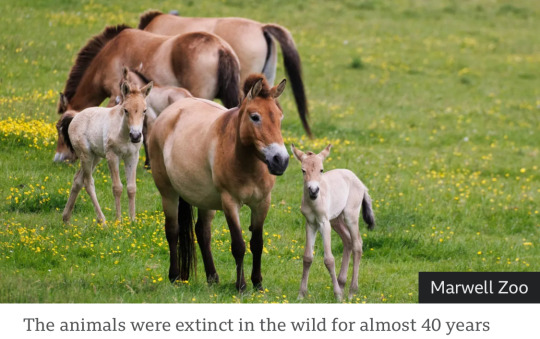
“[The Marwell Zoo in GB] said it was "delighted" to welcome the arrivals to the endangered Przewalski’s horse herd. All four are female and said to be "doing well" after two were born in May and two in June. […] “These horses, that were previously listed extinct in the wild, are an example of how zoo breeding programmes can help restore threatened species around the world.” […] All the Przewalski’s horses alive today are descended from just 12 individuals. Current estimates suggest there are 178 mature individuals living in the wild.”
2. Restoring woodlands and planting trees for sustainability success

“In 2023, [the Marwell Zoo] planted 9,000 new trees […] both within the zoo and on our surrounding land. […] Marwell tries to encourage natural feeding behaviour and nutrition by including leafy material [in animals’ feed] as much as possible. […] Planting more trees and enhancing management of our existing woodlands, prepares the way to further self-sufficiency in browse production in the future. Plus, it creates new habitats for wildlife in our woodland areas.”
3. Inclusive Playgrounds Allow Children Of All Abilities To Play

“With ramps allowing children in wheelchairs to ascend the central play structure, as well as numerous other swings and apparatus usable for children of all abilities, the 16,000-square-foot P.K.’s Place is St. Paul’s first fully inclusive playground. […] To be universally accessible, a play area must have at least 70% of its play features fully accessible, far more than required by the Americans with Disabilities Act (ADA). […] Play areas should allow parents and grandparents with disabilities to participate as well.”
4. Combination treatment can increase human insulin-producing cells in vivo
“[Diabetes-model mice] were treated with the combination therapy [of a plant product called harmine and “a widely used class of type 2 diabetes therapy”] and their diabetes was rapidly reversed. Strikingly, human beta cell numbers increased by 700 percent over three months with this drug combination. "This is the first time scientists have developed a drug treatment that is proven to increase adult human beta cell numbers in vivo. This research brings hope for the use of future regenerative therapies to potentially treat the hundreds of millions of people with diabetes," said Dr. Garcia-Ocaña, the paper's corresponding author.”
5. Decades of Dedication: Australia’s Largest Ongoing Urban Restoration Project
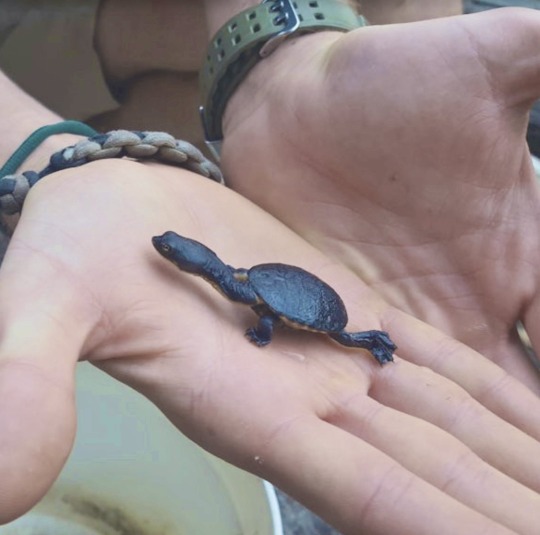
“[Friends of Lake Claremont] has transformed the area into a thriving ecosystem, re-establishing native habitats and fostering biodiversity. This year, 800 native seedlings (100 trees, 350 shrubs and 350 ground covers) have been planted on the northwestern buffer of Lake Claremont. Volunteers replaced a large Port Jackson fig (Ficus rubiginosa) affected by [beetle] infestation with native plants to enhance the local wildlife habitat, thereby benefiting insects, frogs, birds and brown bandicoots. […] Overall, the project contributes to the area’s function as a regional ecological corridor, linking inland bushlands, the Swan River and the Indian Ocean.”
6. Important habitat for fish in Heart of the Fraser now conserved

“British Columbia’s iconic salmon now have more protected spawning habitat in the lower Fraser River, thanks to the Nature Conservancy of Canada’s (NCC’s) conservation acquisition of Carey Island. […] Carey Island and its gravel channels offer calm and crucial spawning and rearing habitat for the river’s fish and aquatic species. […] The Pelólxw Tribe […is also] actively working to restore the resilience of aquatic habitat within this stretch of the Lower Fraser. NCC is exploring opportunities to collaborate with the Pelólxw Tribe in support of their vision for stewardship of the area, which prioritizes both ecological and cultural values.”
7. Prime editing efficiently corrects cystic fibrosis mutation in human lung cells
“[R]esearchers have developed a gene-editing approach that efficiently corrects the most common mutation that causes cystic fibrosis, found in 85 percent of patients. With further development, it could pave the way for treatments that are administered only once and have fewer side effects. The new method precisely and durably corrects the mutation in human lung cells, restoring cell function to levels similar to that of Trikafta [the standard treatment since 2019].”
8. Montana’s High Court Considers a Constitutional Right to a Stable Climate

“At issue was the appeal of a decision last year, when a Montana judge blocked a state law that prohibited agencies from considering climate impacts when deciding whether to approve fossil fuel projects such as new power plants, pipelines or mining. The ruling, by District Judge Kathy Seeley, was prompted by a lawsuit filed by 16 youths who argued that the law violated Montana’s constitutional right to a “clean and healthful environment.” It was the first ruling in the United States to effectively establish constitutional rights to a stable climate[….]”
9. The US is about to get its first solar-covered canal

“The first canal-based solar project in the U.S. is nearing completion on tribal lands south of Phoenix, Arizona. […] The long, narrow solar array design would snake along the line of the canal and tap into the local electrical distribution grid every 1,000 feet, or every one megawatt. […] “Canal solar allows for greater power production per land size, cleaner water, less power transmission losses, and significant reduction in evaporation[….]” Covering the entire 8,000 miles of canals and waterways managed by the Bureau of Reclamation with solar panels could generate over 25 gigawatts of renewable energy and reduce water evaporation by tens of billions of gallons[….]”
10. Camera traps offer glimpse of first beaver born in Northumberland for 400 years
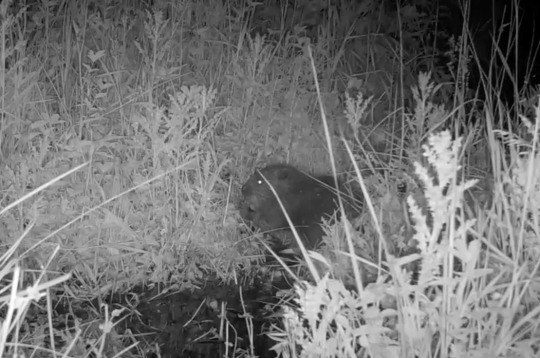
“"It’s such a relief that they have bred successfully and to see a new fluffy kit swimming with the family[….]” In just one year [since releasing the beavers], there has been a noticeable increase in resident trout, says the National Trust, along with more regular visits from kingfishers and grey herons. There are more insects at the site, too, thanks to the organic matter that builds up behind the dams, which in turn provides food for Daubenton’s bats. […] Beavers also play an important role in creating habitats that are more resilient to the effects of climate change[….]”
July 1-7 news here | (all credit for images and written material can be found at the source linked; I don’t claim credit for anything but curating.)
#hopepunk#good news#horse#zoo#nature#extinct species#sustainability#forest#children#disability#playground#disabled#wheelchair#diabetes#medicine#science#urban#biodiversity#ecosystem#fish#first nations#cystic fibrosis#gene editing#climate change#climate#youth#human rights#solar panels#solar energy#beaver
330 notes
·
View notes
Text
Get ready for more ghoul kit headcannon (feel free to share your own. I adore them)
Water ghoul kits squeak like crocodiles
Earth ghoul kits are quiet, they don't usually make sound but a few bleat like a lamb or a deer.
Fire ghoul kits make grunting noises.
Air ghoul kits chirp and whistle.
And Quintessence ghouls mimic the noises other kits make or they don't make noise at all.
Water ghoul kits make the most noise because they're not used to being heard underwater so they don't know when to be quiet. One of the many reasons why they're separated from other kits in the repatriation program.
Just imagine walking into the aquatic nursery and hear
"Squeak squeak sqeak squeak squeak squeak" as all of the water kits just watch you. They also make frog noises if they sleep close to the surface of their aquariums (they sleep in aquariums because kits are more prone to drying out and getting sick than adults.)
Most ghoul kits are fine with whatever element their caretakers are in the Repatriation Program. Water kits, however, need water ghoul caretakers or a multi ghoul with a water ghoul trait for the same reason why they are separated and in aquariums. They will dry out when being handled and in a pouch, especially when in a pouch.
Quintessence ghouls have the potential to handle them without drying them out, but even then they have to take precautions.
Fire ghoul kits aren't as hot as the adults, as in they're lukewarm, so they can be handled comfortably... until they're fussy. They burn hot when they get fussy and have to be handled with oven mitts by non fire ghouls.
Earth kits are often times the biggest out of all the elements, but sometimes that isn't the case. Pebble was always small, even as a kit.
The cuddliest kits are the air and Quintessence kits. That's just how they're brought up. Air kits are used to roosting with nest mates. Quintessence kits are raised communally, they take the saying "it takes a village to raise a child" very literally.
Fire kits aren't the temperamental ones, it's the air kits. Air kits are territorial over things, it's just their nature. They mostly grow out of it.
#the band ghost#nameless ghouls#ghost#ghost band#ghost bc#headcanon#ghoul kits#ghoul repatriation program#water ghoul kits#fire ghoul kits#air ghoul kits#earth ghoul kits#quintessence ghoul kits
355 notes
·
View notes
Text
Round 2 - Chordata - Actinopterygii
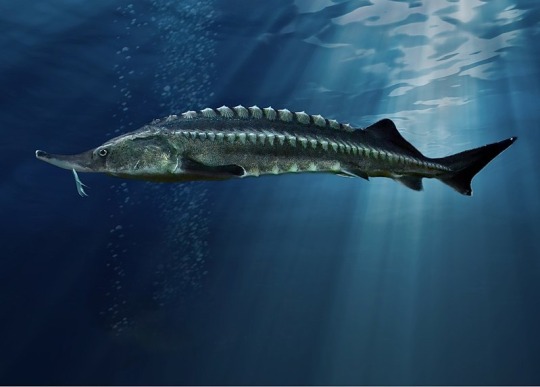
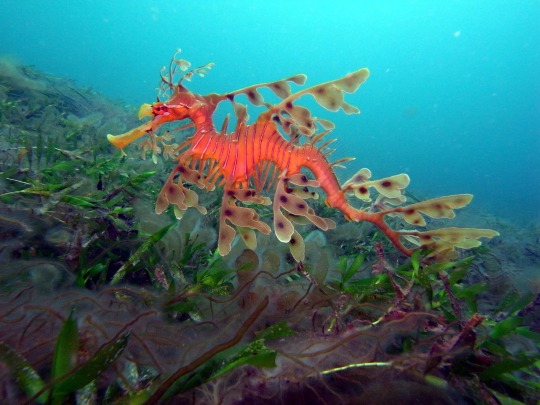

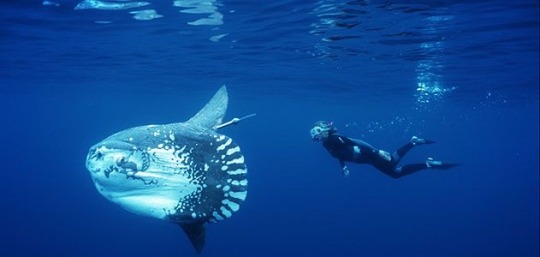
(Sources - 1, 2, 3, 4)
Over 50% of chordate species are Actinopterygians (“Ray-finned Fishes”). There are over 30,000 species, comprised of the Polypteriformes (“Bichirs” and “Reedfish”), Acipenseriformes (“Sturgeons” and “Paddlefish”), Amiiformes (“Bowfins”), Lepisosteiformes (“Gar”), and the Teleosts (about 40 orders containing all rest of the actinopterygians).
Ray-finned Fishes are so called because of their lightly built fins made of skin webbings supported by thin bony spines. Actinopterygians are unique for their swim bladder, an organ that allows them to adjust their buoyancy. They are the most abundant free-swimming aquatic animals and can be found almost anywhere there is water. They come in a vast majority of sizes, shapes, scale-types, fin-arrangements, colors, and behaviors, from the 8 mm (0.3 in) long Paedocypris to the 11 m (36 ft) long Giant Oarfish (Regalecus glesne) to the 2,744 kg (6,049 lb) Giant Sunfish (Mola alexandrini). They have feeding strategies ranging from predatory to grazing to filter-feeding.
In most actinopterygians, males and females exist and reproduce through external fertilization. However, some species utilize sequential hermaphroditism, in which they start life as females and convert to males at some point. In a few species, they start life as males and convert to females. Some species give live birth, and some species self-fertilise. Some abandon their young, while some practice maternal and/or even paternal care.
The earliest known actinopterygian is Andreolepis hedei, from the Late Silurian. The teleosts in particular diversified wildly during the Mesozoic, resulting in the high diversity of shapes we see today. The earliest fossil relatives of modern teleosts, (Prohalecites and Pholidophorus), are from the Triassic period, though it is suspected that teleosts originated already during the Paleozoic Era.
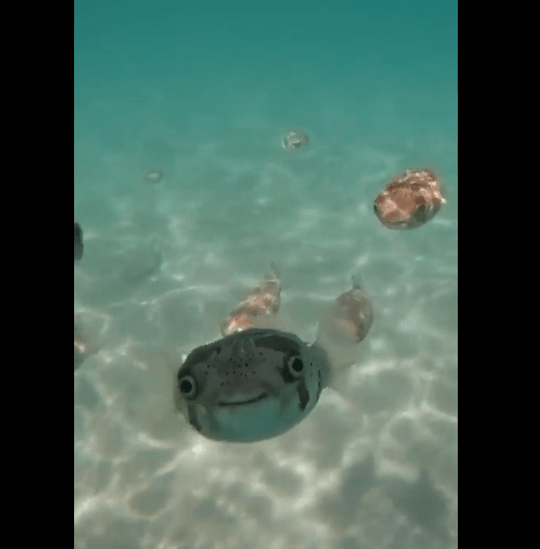
Propaganda under the cut:
Many Actinopterygians, especially those that live in the deep sea, are bioluminescent, glowing in a variety of colors and patterns to attract prey, mates, or even just communicate.
Some species of Puffer Fish (Family Tetrapdontidae) are highly poisonous, second only among vertebrates to the Golden Dart Frog (Phyllobates terribilis).
The most venomous fish is the Reef Stonefish (Synanceia verrucosa). The spines on its back produce a venom which can cause severe pain, shock, paralysis, and tissue death in humans.
Male Seahorses (Genus Hippocampus) are known for having a pouch in which they carry eggs laid by the female.
The Harlequin Tuskfish (Choerodon fasciatus) has electric blue vampire teeth.
Speaking of teeth, Serrasalmids have jaws ranging from human-looking nutcracker teeth to bear-trap looking flesh-eating chompers.
The Mandarinfish (Synchiropus splendidus) and the Picturesque Dragonet (Synchiropus picturatus) are the only two vertebrate species known to produce their own true blue coloring. Blue as a color is usually a result of reflected light, and almost all cells that are perceived as blue are actually a reflective black. However, these two mandarinfish species have cyanophores, which are both blue in pigment and reflective, making them the most blue animals in nature.
Many fish are popular in the pet trade (some more ethical pets than others) and some have even been domesticated and bred to display a variety of colors and shapes, including goldfish, koi, Betta, and zebrafish.
Moray Eels (family Muraenidae) have a hidden set of internal jaws, called pharyngeal jaws. While most predatory fish use suction to “inhale” their prey, moray eels just… pull them in.
The Mangrove Rivulus (Kryptolebias marmoratus), a species of killifish, mostly breeds by self-fertilization and can survive for about two months on land. Males are rare, and can only hatch from eggs kept below 19 °C (66 °F).
The most famous pupfish (family Cyprinodontidae, also a type of killifish) is probably the Devils Hole Pupfish (Cyprinodon diabolis). It is a critically endangered species found only in Devil’s Hole, a water-filled cavern in the US state of Nevada. When nearby agricultural irrigation caused the water to drop in the cavern, several court cases ensued, resulting in Devils Hole being declared a National Monument in 1952, including the preservation of adequate groundwater to maintain the pool. As of September 2022, the count showed a total of 263 observed wild pupfish, up from only 35 in 2013.
There are waaaay too many cool fish for me to write about; I keep thinking of cool facts but this is already getting so long and I gotta save some for if this class makes it to the next round 🥲
103 notes
·
View notes
Note
hatred towards mosquitos is obviously super common but is there any reason why they're not as bad as theyre portrayed ? do they have any benefits like controlling another species overpopulation or being a large part of a certain animals diet ? would they happen to help in forensic entomology at all ? i just know that you like a lot of different bugs and maybe could give a different perspective on mosquitos :0
I would say try not to judge an animal based only on its usefulness. All animals are beautiful and interesting in their own right and not just because they're beneficial to us or to another animal or whatever else. I think this is one of the first steps in appreciating all animals, even the ones that can be harmful or irritating.
With that said, I realize it's easier to start appreciating them if you know more about their role in the ecosystem. There are thousands (3500+) of species of mosquito worldwide, and not all of them are blood feeders. And of the ones that do feed on blood, only the females do. Males are nectar feeders, and mosquitoes are pollinators. Look at the mosquitoes you see closely - males will have fuzzy little antennae and they're harmless.
Lots of animals feed on mosquitoes including dragonflies, spiders, bats, birds, frogs, and fish. Mosquito larvae are aquatic, so they provide food for lots of animals both in that form and then in their adult form.
Since some species are disease vectors and disease is a form of population control, yes, they do that as well. Some organisms require mosquitoes as part of their own life cycle (usually other parasites - heartworms come to mind. Let's not judge their lifestyle). And since you asked, mosquitoes can indeed be used in a forensic investigation.
Also...they can be pretty :)
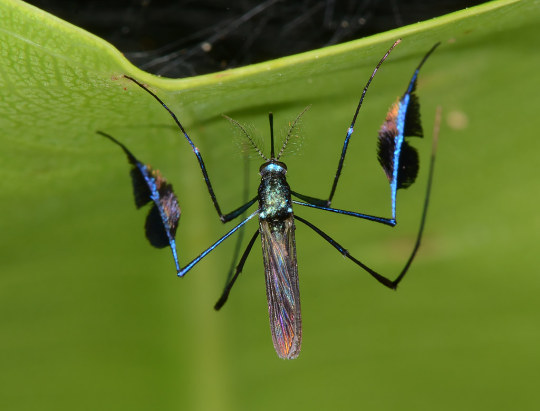
Blue-banner mosquito, Sabetes sp.
Photo by Art Anker - posted with permission // all rights reserved
P. S. - Anyone who makes negative comments on this post will be blocked :)
1K notes
·
View notes
Note
I know you've probably gotten a lot of requests for PRESSURE, but hear me out? Reader X Anglers (platonic), where reader was sent to work in the Hadal Blacksite. Urbanshade was Reader's only chance at a job due to circumstance and they were desperate; they weren't aware what they were getting into UNTIL Urbanshade had signed them up. Now a "handler" of these mutant fish, the least they can do is lessen their misery... Until the Saboteur let's everything aggressive loose.
YAY! Angler request thank you. As annoying as those fish(?) are I think they're very underrated
(in case this needs to be reiterated, this is all PLATONIC)
......
Being desperate for a job and willing to pretty much do whatever it took to get hired anywhere, Urbanshade was the only one willing to offer you an immediate position.
However, you had to be sworn to secrecy and go through an extensive background check and other trials....just for them to transport you to the Hadal Blacksite, where they said you'll be informed of your duties.
Given the extensive security measures already in place, you assumed you were dealing with endangered sea life--or even extinct species Urbanshade revived or rediscovered.
Then you were sent to the heavy containment sector and saw what they were actually hiding down here:
A mutant angler fish--one pink and one grey--a viperfish, a frog with razor sharp teeth, and a dead(?) green blobfish. They were all huge and unlike anything you've seen before.
They were all designated as Z-283, although there were nicknames given to four of them: Pinkie, Blitz, Froger, and Chainsmoker.
The Angler was just, well, Angler.
You didn't know what kind of aquatic rehabilitation facility this was, but they didn't even look like fish that belonged in one, especially as their tanks didn't contain any water, although according to documents, that wasn't even necessary.
Smoke clouded every part of their bodies except their faces, so you couldn't get a good read on how their fins and tails are holding up (assuming they have those at all).
Least to say...it took some time getting used to seeing their frightening looks every shift.
Especially as sometimes Angler, Blitz, and Pinkie liked to scare the hell out of you by shrieking, ramming into the window barriers of their cells, and causing brief power surges.
Your main tasks were to monitor them and keep them fed and happy, although you weren't allowed to make physical contact with them.
Apparently their touch can kill...so you can understand why they needed somebody to watch them at all times and keep their behaviors in check.
But the more you interact with them, the more you start to realize that these anglers (and viperfish, frog, and blobfish) were probably just animals who were simply trying to live within the Let-Vand Zone, only to be taken and shoved into a distressing environment.
Urbanshade claims they aren't "alive", but all you see are scared animals who only knew misery.
You especially didn't like overhearing that they've used prisoners as test subjects. And they're not even food.
Out of water, they can all recognize you by scent and are seemingly aware of how good you've been to them compared to most operatives.
Because when Sebastian/The Saboteur sets them loose and causes the lockdown, and you nearly get killed by one of the many Wall Dwellers...Angler comes to your defense, eating its flesh whole.
At first you think you've finally tamed it--until the fish creature gives you that same murderous and hungry look as it gave those test subjects.
Luckily it gives you a head start and you manage to find a crawlspace out of its line of sight, watching it cause chaos and kill whatever poor sap happened to run into that same room.
Yeah...your job definitely didn't quite prepare you for this kind of scenario..
When the Expendable Protocol is initiated, Sebastian found you and only allowed you live because you could keep the anglers off his back while he's trying to find supplies and figure out how to escape.
They'll listen to you sometimes, although you learn Pinkie and Blitz are very brash and like to do their own things sometimes--while Froger and Chainsmoker are more willing to obey.
But if Pandemonium ever caught sight of you?
May god help you because none of them will.
#clanask#anonymous#roblox x reader#roblox pressure x reader#pressure x reader#pressure angler#pressure z383#platonic#headcanons
77 notes
·
View notes
Text
more WoF tribe hcs because I feel like it
SandWings often swallow their prey whole like a snake
RainWings, when telling stories, subconsciously change their scales to vaguely match those of the dragons in the story. They find it hard to follow stories told by non-RainWings because they rely somewhat on visual cues. Ex: Kinkajou telling Moon about something Winter said and her scales turning white and blue without her thinking about it.
Dragon wing gestures are something not enough ppl talk about but I love thinking about wing movement as it relates to body language. Wings flared to try to intimidate or to convey excitement, wings swept outward and horizontally to gesture to their surroundings, wings used to point at things, to wave hello or goodbye, RainWing wings outstretched and turned red in a gesture not unlike a middle finger, wings pulled back in shock, wings poised to launch into the air in a fight or flight response when startled, etc etc just WING RELATED BODY LANGUAGE/GESTURES!
SkyWings also 100% have at LEAST 30 rude gestures you can do with ur wings
LeafWings have prehensile tails like RainWings
RainWings as well as IceWings have an incredible ability to right themselves in the air when knocked off balance, kinda like cats lol
SandWings would too bc sandstorms
SandWings are actually really good swimmers
MudWings don't swim but walk along the bottom of the lake/river like a hippo
When RainWings trip on frog poison, their scales turn neon colors
SkyWings have extremely well developed vision and can see insane detail from very far away, like an eagle.
RainWings have courtship dances.
Typically, male RainWings and SkyWings have brighter colors and male SkyWings are more commonly red.
Similarly, blue SeaWings are more commonly male.
HiveWings can be hot pink. (Inspiration from that one kind of grasshopper)
Procreation between NightWings and SeaWings sometimes creates children with bioluminescent black lights.
RainWings can learn to speak Aquatic through scale color changes, though it only works with daylight because their scales are only color changing and not bioluminescent.
SeaWings can get high from pufferfish poison, like dolphins.
SeaWings get sick when they transfer from fresh water to salt water and vice versa, similar to altitude sickness.
SkyWings anatomically have the largest hearts of any tribe. (Ah, the irony)
If they eat too many shrimp or similar seafood, IceWings can turn pink. (It's not cute though, it's often a sign of malnourishment.)
RainWings, LeafWings and NightWings are the only tribes able to eat chocolate without getting sick.
Many NightWings are colorblind, but can see colors in visions of the future.
RainWings can mimick sounds and even voices with bonechilling accuracy.
Pantalan dragons do not have forked tongues.
514 notes
·
View notes
Note
hi everybody i’m adrian ^__^ my tumblr isn’t active anymore but since you guys seem to like brigid i wanted to share a bit more info on her that i kept in mind when drafting her design/perosnality with fran
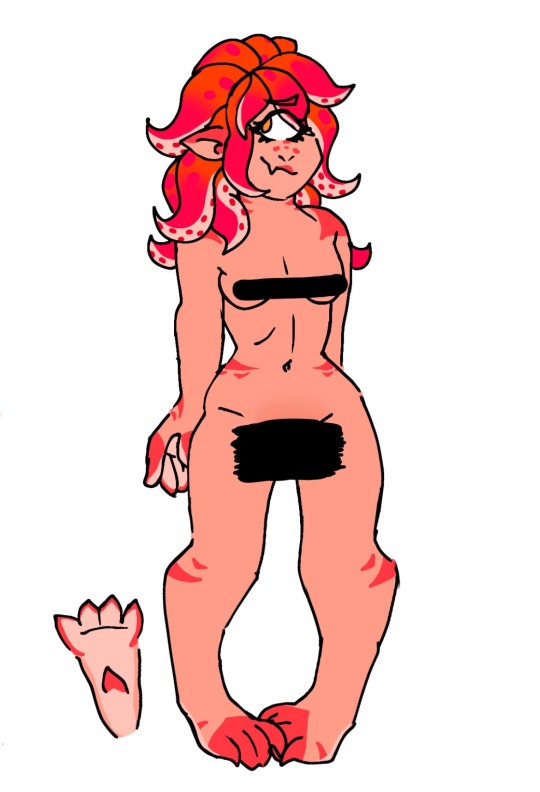
(soz for the nakey, it’s to get a feel for her body type— she’s still a work in progress and i’ve been talking on how to finalize her design with fran! any notes are appreciated <3)
brigid is a biped demon based on aquatic/amphibious creatures. a little squid frog thing. overtime i started to give her more and more nonhuman elements and it started to resonate with us a lot, so here’s the story!
brigid is the child of a witch and a (obviously sentient) beast demon, of which she’s inherited most of her appearance from. for being based on aquatic species, she has an extremely fiery personality + color palette! she would have started off not quite handling her ‘beastly’ traits with much finesse, being a bit clumsy and erratic about it and having a habit of slipping into a frenzy— then bronwyn, someone who handles her beastly side with so much pride and poise, starts to get popular with the boiling isles. she’s an idol bridge can resonate with because she makes something thought to be such an ‘ugly’ side of someone a part of her art, something beautiful!
by the time brigid would be ‘properly introduced’, she’s a firecracker. she’s learned to hone her beast side with confidence and ends up spry, agile and dynamic when she embraces it. she’s still goofy and headstrong, but she owns it! i really enjoyed coming up with her personality and discussing her dynamics/how she fits into the world with fran. i hope you guys have fun with her like we do!
POST THIS SQUIT IMMEDIATELY!!!!!!!!!!!!!
57 notes
·
View notes
Text
Wet Beast Wednesday: giant salamanders
Everyone knows salamanders, right? The little lizard frogs that show up around ponds. Well what if I told you that not all salamanders are little. In fact, some species can get quite large, but none get bigger than the aptly-named giant salamanders. I'm not just talking about any big newt, I'm talking about the unique members of the family Cryptobranchidae.

(Image: a Chinese giant salamander. It is a large, lizard-shaped animal with brown skin and black blotches. Its limbs are short and its tail is flattened to look like a long fin. It has wrinkly folds of skin along the side. End ID)
There are three(ish) species of giant salamander in two genera: the Japanese and Chinese giant salamanders of the genus Andrias and the hellbender of genus Cryptobranchus. The name Cryptobranchidae means "hidden gills", which is appropriate as giant salamanders are unique in that they are the only salamanders who reaming fully aquatic as adults without retaining external gills into adulthood. All salamanders are aquatic as juveniles and have external gills and many groups have independently evolved to remain fully aquatic as adults. However, other species, from axolotls to olms, adapted by retaining their external gills as adults, a trait called neoteny. Giant salamanders have had to find another way, especially since a body as large as their needs quite a bit of oxygen. Their solution was to take a common amphibian trait and turn it up to 11. It is common among amphibians to be able to absorb dissolved oxygen in water through their skin. This is usually a supplement to either gills or lungs, but giant salamanders use it as their main means of respiration. The skin is thin and filled with small veins that can perform gas exchange with the water. Giant salamanders evolved very wrinkly skin flaps along ther sides to increase the amount of surface area available for gas exchange, allowing them to sustain themselves. They do require access to running water with a high oxygen content, as still or low-oxygen water doesn't provide enough oxygen to survive. They do have lungs, but use them more for buoyancy control than breathing.

(Image: a man holding/bear higging a giant salamander. The salamander is longer than his torso, not including the tail. end ID)
The Japanese and Chinese giant salamanders are very closely related to each other and rather similar in physiology and behavior. There's also not just one Chinese salamander. Genetic testing has reveals that what was once called Andrias davidianus is actually a species complex. This is when what was thought to be one species turns out to actually be a group of related species. There is some debate over whether the five identified populations of Chinese giant salamander should be classified as subspecies or their own species, though the latter interpretation seems to be the most popular. All the populations are very similar and can interbreed with each other, so I'll discuss them as a group. The largest of the group (and world's largest amphibian) is the South China giant salamander (Andrias sligoi) which can reach 1.8 m (5.9 ft) and 50 kg (110 lbs), but adults average 1.15 m (3.8 ft) and 25-30 kg (55-66 lbs). The Japanese giant salamander (Andrias japonicus) reaches a slightly smaller maximum size of 1.5 m (5 ft) and 25 kg (55 lbs), with most being smaller. The Chinese and Japanese giant salamanders are closely related enough that they can hybridize.

(Image: a Japanese giant salamander resting on mossy rocks underwater. Its body is light brown with darker blotches and the head is covered in nodules. End ID)
Because of how closely related the Japanese and Chinese salamanders are, their biology and behavior are quite similar. They are mostly a dark brown color, but can also be other tones of brown, reddish, or black. The eyes are lidless, small, and poorly-developed, giving the salamanders poor eyesight. Their primary sense comes from the lateral line, a line of hair cells that extends down the body and sense movement of the water. Using the lateral line, the salamanders can sense the movement of prey and threats in the water around them. They utilize suction feeding, slowly approaching prey, then rapidly opening the mouth to generate a vacuum and suck food into the mouth. The prey is then killed or incapacitated with a powerful bite. The esophagus is lined with powerful muscles and uses mucus as lubricant to allow the salamander to swallow large prey. The head and throat have nodules on them, the arrangement and number of which can be used to differentiate Chinese and Japanese salamanders. Both groups of salamander can secrete a strong-smelling, milky white substance to ward off predators. A low metabolism and generally low activity level allows the salamanders to last of up to a few years between meals. The Chinese salamanders can make vocalizations including barks, hisses, and sounds very similar to the crying of a human baby. The hellbender (Cryptobranchus alleganiensis) is smaller than it's Asian relatives, reaching a length of 30-74 cm (12-29 in) and up to 2.2 kg (5 lbs). They are usually brown or reddish-brown, but can also have a gray, yellowish, or black coloration. Hellbender biology and ecology is fairly similar to that of their relatives.

(Image: a hellbender underwater. It looks like the other two species, but is smaller, lighter brown, and has no nodules on the head. End ID)
Chinese and Japanese giant salamanders live in cool, clear streams and rivers in the Yangtze river basin (Chinese) and the islands of Honshou, Kyushu, and Shikoku (Japan). Hellbenders live in similar treams in the eastern United states, with one population (which may be a subspecies) living in the Ozarks region. As predators, their diets include worms, fish, crayfish, freshwater crabs, other amphibians, and small mammals. They are also cannibals and will opportunistically feed on smaller members of their own species. All species are territorial animals that will attempt to drive others out of their territory, though hellbenders are less territorial than the other species. Hellbenders prefer to live in cavities dug out under rocks, which helps them shelter from predators. Due to their low metabolisms, giant salamanders live much longer than most amphibians. Captive individuals have been recorded living for 60 years (Chinese), 52 years (Japanese), and 25 years (hellbender). All species are nocturnal.

(Image: a hellbender emerging from beneath a rock with a crayfish in its mouth. End ID)
Mating occurs seasonally, triggered by warmer water in the summer. During this period, males will search for ideal nesting sites, leaving their territories if necessary. An idea nesting site is sheltered beneath a rock. There are often fewer nesting sites than males, meaning only the largest and strongest males will be able to claim nests. Males then use courtship displays to woo females. Alternatively, male hellbenders will chase passing females into the nests and refuse to let them leave until they mate. Unlike most salamanders, giant salamanders practice external reproduction, where the female lays eggs and then the male fertilizes them. The male then guards the nest until the eggs hatch. During this period, he will keep the nest and eggs clean and use his tail to keep water moving over them. Males will eat eggs that are unfertilized, unhealthy, or show signs of infection. This helps keep the other eggs as healthy as possible. The offspring are born with external gills, which they will lose as they mature. It can take several years for the larvae to reach maturity.

(Image: a group of giant salamander larvae in captivity. They look like smaller versions of the adults, but with feathery gills emerging from each side of the neck. End ID)
Both hellbenders and Japanese giant salamanders are classified as vulnerable by the IUCN, while Chinese giant salamanders are critically endangered. Their primary threats are habitat loss as streams are dammed, dry up, or become polluted. Warming water temperatures also threaten them. Chinese giant salamanders have experienced a major drop in population since the 1950s. In addition to habitat loss, Chinese giant salamanders are also eaten by humans. While hunting wild specimens is now illegal in China, they are heavily impacted by poaching. The fine for poaching giant salamanders is pathetically small compared to the sale price for one of them, further encouraging poachers. Captive breeding and release programs have shown some success, but may have contributed to the spread of disease. In response to the rarity of the salamanders, a new farming industry has sprung up in, raising giant salamanders for food. The captive population of Chinese giant salamanders in farms vastly exceeds the estimated wild population. Chinese giant salamanders have also been introduced to Japan, where they have been hybridizing with the Japanese salamanders, a major hindrance to conservation efforts. Japanese giant salamanders have been legally protected since 1951. The origin of the name hellbender is unknown. Other names for hellbenders include the water dog, Allegheny alligator, grampus, snot otter, and (my personal favorite) lasagna lizard.

(Image: a holding pen in a Chinese giant salamander farm. Over a dozen salamanders are sitting in a shallow water enclosure stocked with bricks and small fish. End ID)
I will leave this post off with a weird fact. In 1726, a Swiss physician named Johann Jakob Schuechzer declared a fossil giant salamander to be the remains of an ancient human who died in the mythical flood of Noah's ark and named it Homo diluvi, meaning "man who witnessed the deluge". In 1812, paleontologist Georges Cuvier examined the fossil and realized (probably very quickly) that it definitely wasn't a human. Once the fossil was identified as a salamander it was given the name Andrias scheuchzeri. As Andrias means "image of man", both the genus and species names acknowledge Schuechzer's weird idea.

Behold: a man (Image: the original Andrias scheuchzeri fossil that Schuechzer thought as a human. It is a front half of the skeleton of what is clearly a lizard-shaped animal and not a human. End ID)
#wet beast wednesday#giant salamander#chinese giant salamander#japanese giant salamander#hellbenders#salamander#amphibian#Johann Jakob Schuechzer bashing#biology#ecology#zoology#animal facts#informative#educational#image described
132 notes
·
View notes
Text
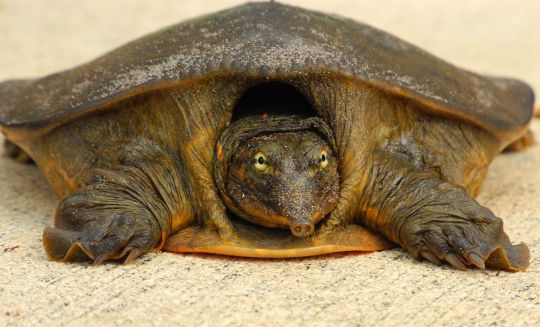
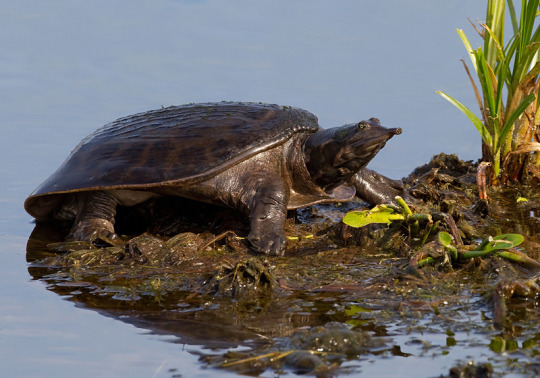

Feeling Out the Florida Softshell Turtle
The Florida softshell turtle (Apalone ferox) is a species of softshell turtle that resides only in the southeastern tropics of the United States, especially along the Atlantic Coast and the Gulf of Mexico. Within this range, they can be found in a number of freshwater environments, including ponds, lakes, swamps, marshes, and urban catchments; they may occasionally also occur in the mouths of slower moving rivers and streams. They generally prefer more muddy bottoms, in which they can bury themselvesand forage for food.
Florida softshell turtles have a highly varied diet, obtained through both active predation and scavenging. When hunting, they may bury themselves at the muddy lake bottom and wait for potential prey to come close enough for an ambush. They are largely carnivorous, feeding on fish, insects, crustaceans, frogs and mollusks, as well as the occasional aquatic plant. Adults are primary predated upon by alligators, while juveniles and eggs may fall prey to foxes, raccoons, birds, and large fish.
Although A. ferox is almost entirely aquatic, adults will readily move overland to find more suitable habitat. They are also frequently spotted basking on rocks or logs. Adults are highly aggressive, and will attack anything they percieve as a threat, including birds, fish, other turtles, and people. In addition to their ferocious bite, they also emit a foul-smelling musk to drive away potential predators.
Mating for the Florida softshell turtle occurs once a year, in the spring from March to July. After mating, females lay their eggs along river or lake banks in clutches of 9-24 eggs. Although they only mate once, females may lay anywhere from 2-7 clutches in a single year. Each clutch incubates for 56 to 80 days, and are immediately independent. Males reach maturity at only 2 years old, while females take 5-8 years; both sexes may live to be over 20 years old in the wild.
Although perhaps not the most attractive turtle, the A. ferox has a very striking appearance. They have a large, flattened body which is covered-- limbs and shell both-- in leathery, olive green or brown skin, with a lighter underside. The shell may also sport darker spots, which help the individual blend in to the muddy substrate. The head is specially distinctive, with a long neck and flattened skull, terminating in a pointed, tubular nose. Individuals may use their extended nostrils to breathe without exposing their body above water. Female Florida softshell turtles are much larger than males; 40.1 cm (15.8 in) in length and 6.65 kg (14.7 lb) compared to only 35 cm (14 in) and 2.68 kg (5.9 lb).
Conservation status: The Florida softshell turtle is considered Least Concern by the IUCN. However, they are threatened by harvesting for meat and the pet trade, as well as habitat loss.
If you like what I do, consider buying me a ko-fi!
Photos
Andrea Westmoreland
Paul Cools
J.D. Willson
#florida softshell turtle#Testudines#If you like what I do#consider buying me a ko-fi!#softshell turtles#turtles#reptiles#freshwater fauna#freshwater reptiles#wetlands#wetland reptiles#lakes#lake reptiles#north america#southern north america
91 notes
·
View notes
Text
Knowing our Arcanists 2: Eternity
Welcome to entry two of my series: "Knowing our Arcanists"! This is a series in which I introduce and tell the stories of our fellow characters in Reverse: 1999, and next up is: Eternity!

Eternity was my first main DPS in the game and she had always been intriguing as she has quite the vague story even as a 1.0 character. As such, a lot of this write up is mainly an interpretation of my own. Now, lets get started.
Eternity, born Winnifred, is an American arcanist coming from Exeter, Rhode Island,USA. Born on December 25th, she currently holds a very interesting arcane skill: immortality maintained via connection to aquatic creatures. She has a large connection to the ocean and its animals, and she maintains her immortality by the consumption of sea animals and blue blood. At the same time, she's known to be able to tame sea creatures and manipulate water (or blue blood) to lull one's mind into placidity.
Half of this makes the idea that she is a vampire, which isn't wrong, however she's not exactly one, per se. Since vampires in this game are more known to be associated with the Infected. (which she isn't)
While we don't know much about her childhood, her story starts out early into her adulthood, when she left her candy business in Exeter to avoid being hunted down by the townspeople. Eternity was 'accused' of being a vampire as young people were dying left and right due to an unknown disease—later found to be tuberculosis—whilst Eternity herself thrived without struggle.
Upon leaving, she started out a new arcanum shop business, which sold various items that has a quite range of uses; they may be functional but they're also a bit unconventional. (she currently has a feud with the Foundation about an invisibility cloak and was known to have sold transfigured frogs lmao) This made her an efficient arcane craftsman and businesswoman over time.
Eternity is a very social person, being popular amongst people across the US in all the eras of the 20th Century. Yet, to keep a low profile, Eternity makes efforts to ensure that her identity as an immortal is never revealed. Never making too close of connections, moving from place to place, dismissing people's assumptions about her familiarity. She rose to popularity in the 40s as a socialite between various soldiers (before they were sent off to WWII), then between the 60s to 70s as an actor and TV host, and then in the 90s again as an information broker.
However, she is also a very simple person, never attending late night balls nor staying up past 10 pm. She ends her nights by sitting down and watching The Night Show with a glass of milk. She has a love for talk shows like that, and even wishes to be a guest on it.
Eternity's kindness, transparency, and insightfulness is also known among people who indeed attempt to get close to her. Such one case is of Brian Finn, one of the few people that Eternity made consistent contact with over the course of their lifetime. He left an impression on her as a courageous and unshaken person who never abandoned his ideals over time, even to his deathbed. As such, she rewarded him with a calming and peaceful end.
While continuously growing to be alone as an immortal, Eternity always try to catch up to the latest things to fill that space; tries her best to avoid growing too attached to material things as they're slowly eroded by time. But loneliness can't be escaped, nor can she do anything more to change it. So instead, she remains cordial and involved; always tying up the loose ends, and ensuring to maintain the tranquility in her current life.
#reverse 1999#knowing our arcanists#eternity reverse 1999#shes a mysterious but funny character#her connection with matilda's mom is crazy
56 notes
·
View notes
Note
In frog prince au, how yn was taken by sun and moon and how their kingdom looks like??
A sub aquatic cave, hidden kelpie florest or other illustrations???
How sun and moon subjets look like?? They are also aquatic creatures??
How yn is with everything???
So... it's actually a large flooded valley! It used to be a small kingdom with small villages surrounding the main city and palace. Some buildings and structures poke out of the water here and there, but most are completely submerged. The trees have also grown tall enough that most can reach out quite a bit from the water. I imagine the area to kinda look like a mangrove, swamp, and Amazon river all smashed together.
I'm still working on this, but I imagine Y/n is driving around in a motor boat, and sees one of the boys(probably Moon) watching them from the shade of one of the half-emerged trees, before he dives underwater. Y/n keeps exploring and reaches the center of the valley and finds the palace. Y/n meets Sun who seems very excited to meet them. Asking questions, being a bit too outgoing. Then from behind Moon yoinks y/n out of the boat and drags them underwater(he is wearing some of his royal garments to protect y/n from getting poisoned)
Since the palace is only halfway emerged, there are a lot of rooms inside that haven't been flooded. But it's like a beaver lodge, as the only entrances (if you don't count windows) are under water. So basically, y/n is completely trapped, because they can't hold their breath long enough to escape. Especially since the bits of the palace that are underwater are like a maze.

As for the subjects, they can be any animal that is at least adapted for swimming. They are also easy to tell apart from normal animals because of their bright colors and distinct patterns (these colors and patterns vary from individual to individual). They can't really talk, but can understand human speech. Sun and Moon can understand them though. The subjects have been around for a long time, but are still the same age they were when the curse was put into affect. So kids are still kids and stay as baby animals, and adults are still adults and stay as adults animals.
Y/n is definitely terrified and has no clue what's going on.
Anyway, hopefully, this information is helpful!
#dca au#answered#digital art#dca frog au#poison dart frog au#frog prince au#dca prince au#poisonous princes#prince sun#prince moon#frog moon#frog sun
55 notes
·
View notes
Text
AQUATIC SNEGLE FURY
(OPEN SPECIES BY SOKODRAWS/SOKOISTRYING)

Aquatic Snegle Fury is a Night Fury subspecies that evolved to live almost 100% of their life in the ocean.
This species evolved from Night Furies that lived at ocean shores and ate huge amounts of sea slugs that infested that part of the ocean.
They started mutating and incorporating some of the sea slug attributes into their bodies.
Aquatic Snegle Furies cannot breath underwater, but (similarly to sperm whales) can hold their breath up to 90 minutes.
They live their entire lives under water, only coming to shore to lay and look after their eggs. As soon as the eggs hatch they follow their mother to the ocean.
Aquatic Snegle Furies have quite a big variation in body shape, color, and size. While their main body shape resembles that of a typical Night Fury, their wings, tails and fins can have any shape. Some of their body parts can be partially translucent.
The often bright colors of these reef-dwelling species imply that these animals are under constant threat of predators. Because of their small size they are subject to getting eaten by bigger dragons. Still, the color can warn other animals of the fury's toxic stinging cells (nematocysts) or offensive taste.
All Aquatic Snegle Furies have razor-sharp teeth, and a pair of rhinophores—sensory primary antennas used mostly for the sense of smell — on their head. They can have any number of secondary antennas, but those only help with the feeling of ocean currents and the movement around them.
Their main source of food is small species of fish, jellyfish, bryozoans, and sea anemones.
AQUATIC SNEGLE FURY VISUAL GUIDE:

Many specimen can have the same mutation but there will never be two AS Furies with identical markings/attributes, even if they mutated from the same sea slug.
These furies are almost completely covered in scales, since they did mutate from Night Furies. Though, their bellies, throats, and the under side of their tail (closest to the belly) are only covered in thin slimy skin (similar to a frog in texture). That skin is made of toxic stinging cells.

Aquatic Snegle Fury saliva contains a batrachotoxin, which can cause reactions like swelling, nausea, and muscle paralysis, when exposed to in big quantities.

The paw pad trait will appear in all 4 limbs. The pads are sticky and help the Fury grab onto the environment when the ocean current is too strong.

Aquatic Snegle Furies don't use plasma blasts often. For one, it uses precious oxygen, but they usually don't have a need for it. They're quite a docile species.

There's no size difference based on gender. Actually — similarly to sea slugs — Aquatic Snegle Furies don't have any traits specific to gender, since the vast majority of them are hermaphrodites. Some AF Furies will be born as one specific sex (either male or female), but are capable of changing it later in their life.
THIS IS AN OPEN SPECIES, FEEL FREE TO MAKE A ASF CHARACTER BUT PLEASE FOLLOW THE SPECIES RULES
PLEASE DON'T MAKE ASF ADOPTS TO SELL FOR PROFIT
HAVE FUN :D
(if you need a resource to look for sea slug species, i highly recommend en.seaslug.world for inspo)
#aquatic snegle fury#night fury#httyd#httyd species#night fury subspecies#open species#original species#fan species#how to train your dragon#ASFury#long post#httyd fanart#httyd fan species
80 notes
·
View notes